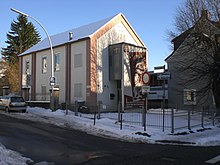Synagogue (St. Ingbert)
The St. Ingbert Synagogue was a Jewish place of worship in St. Ingbert in Saarland , which at the time was Bavarian . The building on the corner of Josefstaler Strasse and Staugärtenstrasse has been heavily changed today and now houses the Protestant Office for Religious Education.
history
After the first settlements of Jews in the up-and-coming industrial city with Mendel Beer in 1810 and the granting of city rights , probably in 1829, the need to have one's own house of worship grew. After 1860 the number of parish members had risen to over 50 and the small prayer room in the house of the soap manufacturer Wolfgang Kahn (–1888) Poststrasse, corner of Ludwigstrasse became too cramped. In addition, Kahn needed the space himself to expand his business. He made his property Josefstaler Straße 22 available to the community for 1400 guilders , and the community set up a building fund. By 1875, 3000 guilders were collected, the cost estimate was 5300 guilders. The remaining financing was done with the help of a loan, so that the construction plan was approved in April 1875. Executing construction companies were Johann Josef Hellenthal for the masonry and Georg Uhl for the carpentry and other St. Ingbert craftsmen.
The inauguration took place on January 14, 1876 with great sympathy from the population, who showed great tolerance towards other religions. The St. Ingberter Anzeiger wrote:
“The considerable pageant moved according to the program at 2 o'clock with delivery of the holy Torah scrolls, with gunfire and music through the flagged streets from the old to the new synagogue, wherever the royal district administrator opened the door of the new synagogue after a previous address The interior was simple and tasteful, which could not grasp all of the participants and where yesterday's beautiful festival came to an end with an uplifting church celebration. "
The members of the Israelite community were fully integrated into the social fabric. Many fellow citizens of the Jewish faith exercised civil professions, including Wolfgang Kahn, who worked in public administration. In addition, his soap factory with 70 employees was considered an important employer at the time and was an army supplier. According to Bavarian law, the St. Ingberter Kultusgemeinde was a private church society whose status was comparable to that of a registered association . Since 1852 it has been called "Israelitische Kultusgemeinde St. Ingbert (Pfalz)". The community belonged together with Zweibrücken , Homburg , Blieskastel , Ixheim and Gersheim to the Rabbinate District Zweibrücken , which was moved to Pirmasens in 1911 .
After the Second World War , in which the Jewish population was almost wiped out or had previously emigrated, three more services were held under American protection. In 1947 the neighboring parish of the Christ parish set up a prayer room in the former synagogue, but later it was transferred back to the Saar synagogue parish . This in turn sold the property to the Protestant parish.
During the subsequent renovation, the external shape of the building in particular was massively changed. A mosaic by the artist Fritz Berberich from Schnappach was created at the entrance portal , which reproduces the Old Testament story of the three young men Schadrach, Meschach and Abed-Nego in the furnace. Below the mural is quoted from the book of Daniel (Dan 3): "Behold, our God, whom we honor, can certainly save us from the furnace of fire".
As early as 1860, the Jewish community of St. Ingbert was able to inaugurate its own school building, in which an elementary school was set up. There was a teacher's apartment on the upper floor. Jewish schools were basically considered to be private schools , which was also in the interests of the Jewish community, because it enabled them to realize their ideas about teaching their culture, language and religion. In addition to the responsible district rabbi, the state district government was also responsible. The school building was located on the neighboring property, Josefstaler Straße 20.
Web links
literature
- Heiner Baus: Two buildings of the former Jewish community of St. Ingberts. In: Saarpfalz, sheets for history and folklore, ISSN 0930-1011 , issue 2010/2, p. 56ff.
Individual evidence
- ^ Theresia Zimmer, Landesarchivverwaltung Rheinland-Pfalz: Inventory of the sources on the history of the Jewish population in Rhineland-Palatinate and Saarland from 1800 / 1815-1945: Landesarchiv Speyer, self-published by the Landesarchivverwaltung Rheinland-Pfalz, 1982, p. 452
- ↑ The Rabbinate District Zweibrücken is relocated to Pirmasens (1911) on alemannia-judaica.de
Coordinates: 49 ° 16 '58.12 " N , 7 ° 6' 50.08" O

